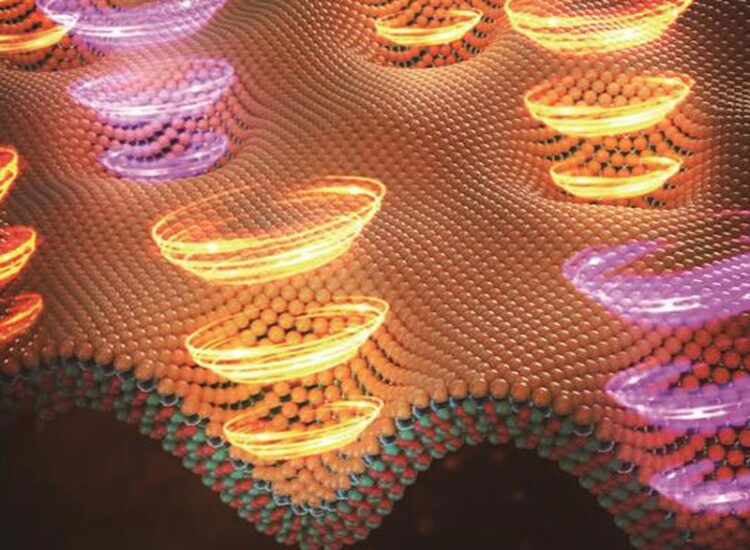New quantum device generates single photons and encodes information

Formed within wells indented into the stack of two different layered materials, a monolayer semiconductor and an anti-ferromagnetic crystal, the chiral quantum light emissions rise up out of the material and could be used for quantum information and communication applications.
Credit: Los Alamos National Laboratory
Approach is a step toward using single photons in quantum communication and information processing.
A new approach to quantum light emitters generates a stream of circularly polarized single photons, or particles of light, that may be useful for a range of quantum information and communication applications. A Los Alamos National Laboratory team stacked two different, atomically thin materials to realize this chiral quantum light source.
“Our research shows that it is possible for a monolayer semiconductor to emit circularly polarized light without the help of an external magnetic field,” said Han Htoon, scientist at Los Alamos National Laboratory. “This effect has only been achieved before with high magnetic fields created by bulky superconducting magnets, by coupling quantum emitters to very complex nanoscale photonics structures or by injecting spin-polarized carriers into quantum emitters. Our proximity-effect approach has the advantage of low-cost fabrication and reliability.”
The polarization state is a means of encoding the photon, so this achievement is an important step in the direction of quantum cryptography or quantum communication.
“With a source to generate a stream of single photons and also introduce polarization, we have essentially combined two devices in one,” Htoon said.
Indentation key to photoluminescence
As described in Nature Materials, the research team worked at the Center for Integrated Nanotechnologies to stack a single-molecule-thick layer of tungsten diselenide semiconductor onto a thicker layer of nickel phosphorus trisulfide magnetic semiconductor. Xiangzhi Li, postdoctoral research associate, used atomic force microscopy to create a series of nanometer-scale indentations on the thin stack of materials. The indentations are approximately 400 nanometers in diameter, so over 200 of such indents can easily be fit across the width of a human hair.
The indentations created by the atomic microscopy tool proved useful for two effects when a laser was focused on the stack of materials. First, the indentation forms a well, or depression, in the potential energy landscape. Electrons of the tungsten diselenide monolayer fall into the depression. That stimulates the emission of a stream of single photons from the well.
The nanoindentation also disrupts the typical magnetic properties of the underlying nickel phosphorus trisulfide crystal, creating a local magnetic moment pointing up out of the materials. That magnetic moment circularly polarizes the photons being emitted. To provide experimental confirmation of this mechanism, the team first performed high magnetic field optical spectroscopy experiments in collaboration with National High Magnetic Field Laboratory’s Pulsed Field Facility at Los Alamos. The team then measured the minute magnetic field of the local magnetic moments in collaboration with the University of Basel in Switzerland.
The experiments proved that the team had successfully demonstrated a novel approach to control the polarization state of a single photon stream.
Encoding quantum information
The team is currently exploring ways to modulate the degree of circular polarization of the single photons with the application of electrical or microwave stimuli. That capability would offer a way to encode quantum information into the photon stream.
Further coupling of the photon stream into waveguides — microscopic conduits of light — would provide the photonic circuits that allow the propagation of photons in one direction. Such circuits would be the fundamental building blocks of an ultra-secure quantum internet.
The paper: “Proximity Induced Chiral Quantum Light Generation in Strain-Engineered WSe2/NiPS3 Heterostructures.” Nature Materials. DOI: 10.1038/s41563-023-01645-7
The funding: Laboratory Directed Research and Development (LDRD) program at Los Alamos National Laboratory; the U.S. Department of Energy Basic Energy Sciences, QIS Infrastructure Development Program; and the Quantum Science Center, a national QIS Research Center supported by the DOE Office of Science.
Journal: Nature Materials
DOI: 10.1038/s41563-023-01645-7
Method of Research: Experimental study
Subject of Research: Not applicable
Article Title: Proximity-induced chiral quantum light generation in strain-engineered WSe2/NiPS3 heterostructures
Article Publication Date: 17-Aug-2023
Media Contact
Brian Keenan
Los Alamos National Laboratory
bkeenan@lanl.gov
Cell: 505-412-8561
Original Source
All latest news from the category: Information Technology
Here you can find a summary of innovations in the fields of information and data processing and up-to-date developments on IT equipment and hardware.
This area covers topics such as IT services, IT architectures, IT management and telecommunications.
Newest articles

NASA: Mystery of life’s handedness deepens
The mystery of why life uses molecules with specific orientations has deepened with a NASA-funded discovery that RNA — a key molecule thought to have potentially held the instructions for…

What are the effects of historic lithium mining on water quality?
Study reveals low levels of common contaminants but high levels of other elements in waters associated with an abandoned lithium mine. Lithium ore and mining waste from a historic lithium…

Quantum-inspired design boosts efficiency of heat-to-electricity conversion
Rice engineers take unconventional route to improving thermophotovoltaic systems. Researchers at Rice University have found a new way to improve a key element of thermophotovoltaic (TPV) systems, which convert heat…



